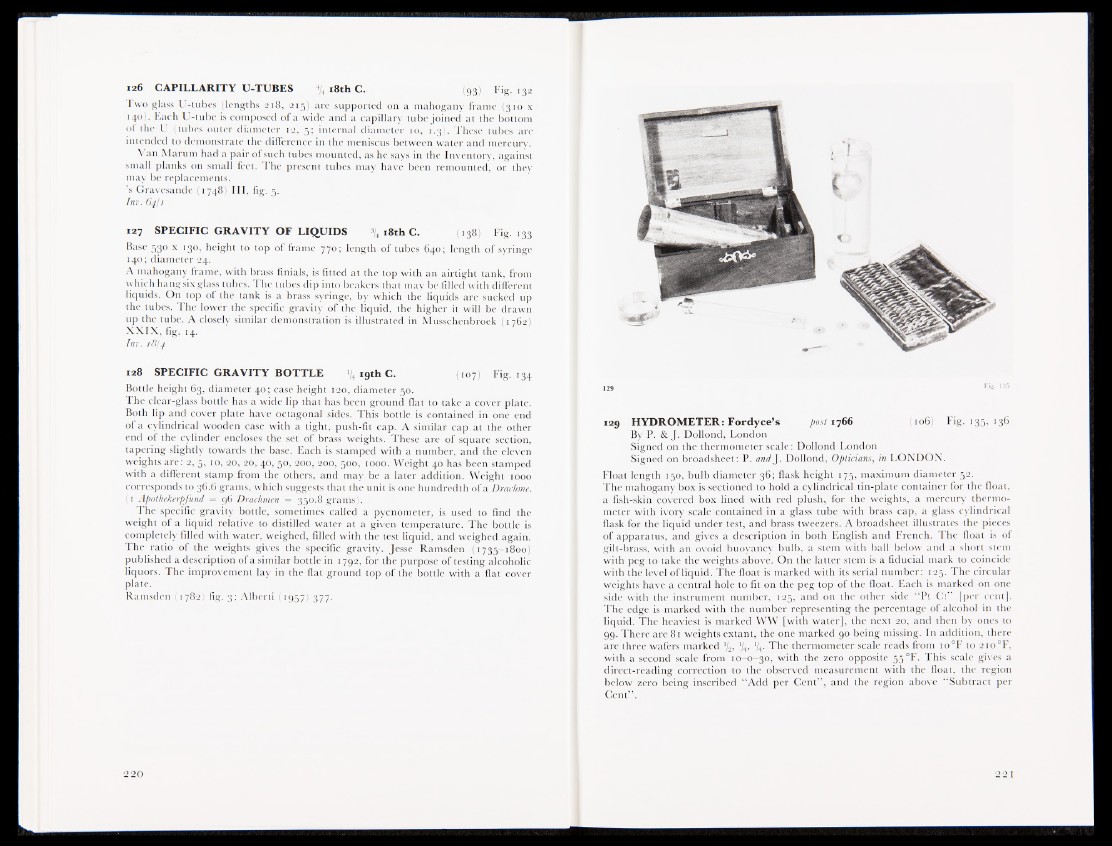
126 CAPILLARITY U-TUBES % 18th C. (93) Fig. 132
Two glass U-tubes (lengths 218, 215) are supported on a mahogany frame (310 x
140). Each U-tube is composed of a wide and a capillary tube joined at the bottom
ol the U (tubes outer diameter 12, 5; internal diameter 10, 1.3).These tubes are
intended to demonstrate the difference in the meniscus between water and mercury.
\ an Marti m had a pair of such tubes mounted, as he says in the Inventory, against
small planks on small feet. The present tubes may have been remounted, or they
may be replacements.
’s Gravesande (1748) III, fig. 5.
Inv. 64/1
127 SPECIFIC GRAVITY OF LIQUIDS % 18th C. (138) Fig. 133
Base 530 x 130, height to top of frame 7 7 0 length of tubes 640; length of syringe
140; diameter 24.
A mahogany frame, with brass finials, is fitted at the top with an airtight lank, from
which hang six glass tubes. The tubes dip into beakers that may be filled with different
liquids. On top of the tank is a brass syringe, by which the liquids are sucked up
the tubes. The lower the specific gravity of the liquid, the higher it will be drawn
up the tube. A closely similar demonstration is illustrated in Musschenbroek (1762)
XXIX, fig. 14.
Inv. 18/4
128 SPECIFIC GRAVITY BOTTLE % 19th C. f t 07« Fig.,134
Bottle height 63, diameter 40; case height 120, diameter 50.
The clear-gl ass bottle has a wide lip that has been ground flat to take a cover plate.
Both lip and cover plate have octagonal sides. This bottle is contained in one end
of a cylindrical wooden case with a tight, push-fit cap. A similar cap at the other
end of the cylinder encloses the set of brass weights. These are of square section,
tapering slightly towards the base. Each is stamped with a number, and the eleven
weights are: 2, 5, to,-'20, 20, 40, 50, 200, 200, 500, 1000. Weight 40 has been stamped
with a different stamp from the other%jand may be a later addition. Weight 1000
corresponds to 36.6 grams, which suggests that the unit is one hundredth of a Drachme.
(1 Apothekerpfund «496 Drachmen I 350.8 grams').
The specific gravity bottle, sometimes called a pycnometer, is used to find the
weight of a liquid relative to distilled water at a given temperature. The bottle is
completely filled with water, weighed, filled with the test liquid, and weighed again.
The ratio of the weights gives the specific gravity. Jesse Ramsden «735-1800)
published a description of a similar bottle in 1792, for the purpose of testing alcoholic
liquors. The improvement lay in the flat ground top of the bottle with a flat cover
plate.
Ramsden (1782) fig. 3; Alber t i (1957) 377.
129 HYDROMETER: Fordyce’s post 1766 (106) Fig. 135, 136
By P. & J. Dollond, London
Signed on the thermometer scale: Dollond London
Signed on broadsheet: P. andJ. Dollond, Opticians, in LONDON.
Float length 150, bulb diameter 36; flask height i||p;j maximum diameter 52.
The mahogany box is sectioned to hold a cylindrical tin-plate container for the float,
a fish-skin covered box lined with red plush, for the weights, a mercury thermometer
with ivory scale contained in a glass tube with brass cap, a glass cylindrical
flask tor the liquid under test, and brass tweezers. A broadsheet illustrates the pieces
of apparatus, and gives a description in both English and French. The float is of
gilt-brass, with an ovoid buoyancy bulb, a stem with ball below and a short stem
with peg to take the weights above. On the latter stem is a fiducial mark to coincide
with the level of liquid. The float is marked with its serial number: 125. The circular
weights have a central hole to fit on the peg top of the float. Each is marked on one
side with the instrument number, 125, and on the other side “ Pr C.1” [per cent].
The edge is marked with the number representing the percentage of alcohol in the
liquid. The heaviest is marked WW [with waterjBthe next 20, and then by ones to
99. There are 81 weights extant, the one marked 90 being missing. In addition, there
are three wafers marked '4, */4. The thermometer scale reads from io°F to 2io°F,
with a second scale from 10-0—30, with the zero opposite 55 °F. This scale gives a
direct-reading correction to the observed measurement with the float, the region
below zero being inscribed “Add per Cent” , and the region above “ Subtract per
Cent” .